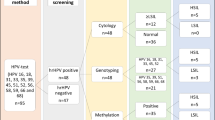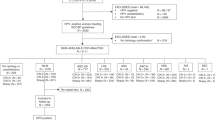Abstract
In the era of primary vaccination against HPV and at the beginning of the low prevalence of cervical lesions, introduction of screening methods that can distinguish between low- and high-grade lesions is necessary in order to maintain the positive predictive value of screening. This case-control study included 562 women who attended cervical screening or were referred for colposcopy and 140 disease free controls, confirmed by histology and/or cytology. The cases were stratified by age. Using routine exfoliated liquid based cytological samples RT-PCR measurements of biomarker genes, high-risk HPV testing and liquid based cytology were performed and used to evaluate different testing protocols including sets of genes/tests with different test cut-offs for the diagnostic panels. Three new panels of cellular biomarkers for improved triage of hrHPV positive women (diagnostic panel) and for prognostic assessment of CIN lesions were proposed. The diagnostic panel (PIK3AP1, TP63 and DSG3) has the potential to distinguish cytologically normal hrHPV+ women from hrHPV+ women with CIN2+. The prognostic gene panels (KRT78, MUC5AC, BPIFB1 and CXCL13, TP63, DSG3) have the ability to differentiate hrHPV+ CIN1 and carcinoma cases. The diagnostic triage panel showed good likelihood ratios for all age groups. The panel showed age-unrelated performance and even better diagnostic value under age 30, a unique feature among the established cervical triage tests. The prognostic gene-panels demonstrated good discriminatory power and oncogenic, anti-oncogenic grouping of genes. The study highlights the potential for the gene expression panels to be used for diagnostic triage and lesion prognostics in cervical cancer screening.



Similar content being viewed by others
References
Forouzanfar MH, Foreman KJ, Delossantos AM, et al. (2011) Breast and cervical cancer in 187 countries between 1980 and 2010: a systematic analysis. Lancet 378:1461–1484. doi:10.1016/S0140-6736(11)61351-2
Vaccarella S, Lortet-Tieulent J, Plummer M, et al. (2013) Worldwide trends in cervical cancer incidence: impact of screening against changes in disease risk factors. Eur J Cancer 49:3262–3273. doi:10.1016/j.ejca.2013.04.024
Elfström KM, Herweijer E, Sundström K, Arnheim-Dahlström L (2014) Current cervical cancer prevention strategies including cervical screening and prophylactic human papillomavirus vaccination: a review. Curr Opin Oncol 26:120–129. doi:10.1097/CCO.0000000000000034
Martin CM, O’Leary JJ (2011) Histology of cervical intraepithelial neoplasia and the role of biomarkers. Best Pract Res Clin Obstet Gynaecol 25:605–615. doi:10.1016/j.bpobgyn.2011.04.005
Horn L-C, Reichert A, Oster A, et al. (2008) Immunostaining for p16INK4a used as a conjunctive tool improves interobserver agreement of the histologic diagnosis of cervical intraepithelial neoplasia. Am J Surg Pathol 32:502–512. doi:10.1097/PAS.0b013e31815ac420
Belinsky SA, Nikula KJ, Palmisano WA, et al. (1998) Aberrant methylation of p16(INK4a) is an early event in lung cancer and a potential biomarker for early diagnosis. Proc Natl Acad Sci U S A 95:11891–11896
Schutte M, Hruban RH, Geradts J, et al. (1997) Abrogation of the Rb/p16 tumor-suppressive pathway in virtually all pancreatic carcinomas. Cancer Res 57:3126–3130
Henken FE, Wilting SM, Overmeer RM, et al. (2007) Sequential gene promoter methylation during HPV-induced cervical carcinogenesis. Br J Cancer 97:1457–1464. doi:10.1038/sj.bjc.6604055
Louvanto K, Franco EL, Ramanakumar AV, et al. (2015) Methylation of viral and host genes and severity of cervical lesions associated with human papillomavirus type 16. Int J Cancer 136:E638–E645. doi:10.1002/ijc.29196
Arbyn M, Ronco G, Cuzick J, et al. (2009) How to evaluate emerging technologies in cervical cancer screening? Int J Cancer 125:2489–2496. doi:10.1002/ijc.24774
Jeney C, Takács T, Sebe A, Schaff Z (2007) Detection and typing of 46 genital human papillomaviruses by the L1F/L1R primer system based multiplex PCR and hybridization. J Virol Methods 140:32–42. doi:10.1016/j.jviromet.2006.10.013
Holmes TG, Donkin A, Witten IH (1994) Weka: A machine learning workbench. Proc Second Aust. New Zeal. Conf. Intell. Inf, Syst 357–361. doi:10.1109/ANZIIS.1994.396988
Wentzensen N, Schwartz L, Zuna RE, et al. (2012) Performance of p16/Ki-67 immunostaining to detect cervical cancer precursors in a colposcopy referral population. Clin Cancer Res 18:4154–4162. doi:10.1158/1078-0432.CCR-12-0270
Bergholz J, Xiao Z-X (2012) Role of p63 in Development, Tumorigenesis and Cancer Progression. Cancer Microenviron 5:311–322. doi:10.1007/s12307-012-0116-9
Gius D, Funk MC, Chuang EY, et al. (2007) Profiling microdissected epithelium and stroma to model genomic signatures for cervical carcinogenesis accommodating for covariates. Cancer Res 67:7113–7123. doi:10.1158/0008-5472.CAN-07-0260
Dennis G, Sherman BT, Hosack DA, et al. (2003) DAVID: Database for Annotation, Visualization, and Integrated Discovery. Genome Biol 4:P3
Patel V, Martin D, Malhotra R, et al. (2013) DSG3 as a biomarker for the ultrasensitive detection of occult lymph node metastasis in oral cancer using nanostructured immunoarrays. Oral Oncol 49:93–101. doi:10.1016/j.oraloncology.2012.08.001
Williamson L, Raess NA, Caldelari R, et al. (2006) Pemphigus vulgaris identifies plakoglobin as key suppressor of c-Myc in the skin. EMBO J 25:3298–3309. doi:10.1038/sj.emboj.7601224
de Bruin A, Caldelari R, Williamson L, et al. (2007) Plakoglobin-dependent disruption of the desmosomal plaque in pemphigus vulgaris. Exp Dermatol 16:468–475. doi:10.1111/j.1600-0625.2007.00557.x
Chen Y, Mistry DS, Sen GL (2014) Highly rapid and efficient conversion of human fibroblasts to keratinocyte-like cells. J Invest Dermatol 134:335–344. doi:10.1038/jid.2013.327
Yugawa T, Narisawa-Saito M, Yoshimatsu Y, et al. (2010) DeltaNp63alpha repression of the Notch1 gene supports the proliferative capacity of normal human keratinocytes and cervical cancer cells. Cancer Res 70:4034–4044. doi:10.1158/0008-5472.CAN-09-4063
Teissier S, Ben Khalifa Y, Mori M, et al. (2007) A new E6/P63 pathway, together with a strong E7/E2F mitotic pathway, modulates the transcriptome in cervical cancer cells. J Virol 81:9368–9376. doi:10.1128/JVI.00427-07
Lin Z, Liu M, Li Z, et al. (2006) DeltaNp63 protein expression in uterine cervical and endometrial cancers. J Cancer Res Clin Oncol 132:811–816. doi:10.1007/s00432-006-0130-8
Pimenta EM, Barnes BJ (2014) Role of Tertiary Lymphoid Structures (TLS) in Anti-Tumor Immunity: Potential Tumor-Induced Cytokines/Chemokines that Regulate TLS Formation in Epithelial-Derived Cancers. Cancers (Basel) 6:969–997. doi:10.3390/cancers6020969
Sambandam Y, Sundaram K, Liu A, et al. (2012) CXCL13 activation of c-Myc induces RANK ligand expression in stromal/preosteoblast cells in the oral squamous cell carcinoma tumor–bone microenvironment. Oncogene. doi:10.1038/onc.2012.24
Airoldi I, Cocco C, Morandi F, et al. (2008) CXCR5 may be involved in the attraction of human metastatic neuroblastoma cells to the bone marrow. Cancer Immunol Immunother 57:541–548. doi:10.1007/s00262-007-0392-2
Singh S, Singh R, Sharma PK, et al. (2009) Serum CXCL13 positively correlates with prostatic disease, prostate-specific antigen and mediates prostate cancer cell invasion, integrin clustering and cell adhesion. Cancer Lett 283:29–35. doi:10.1016/j.canlet.2009.03.022
Feng Q, Wei H, Morihara J, et al. (2012) Th2 type inflammation promotes the gradual progression of HPV-infected cervical cells to cervical carcinoma. Gynecol Oncol 127:412–419. doi:10.1016/j.ygyno.2012.07.098
Guerrero-Preston R, Michailidi C, Marchionni L, et al. (2014) Key tumor suppressor genes inactivated by “greater promoter” methylation and somatic mutations in head and neck cancer. Epigenetics 9:1031–1046. doi:10.4161/epi.29025
Politopoulos I, Gibson J, Tapper W, et al. (2011) Composite likelihood-based meta-analysis of breast cancer association studies. J Hum Genet 56:377–382. doi:10.1038/jhg.2011.23
Koutros S, Schumacher FR, Hayes RB, et al. (2010) Pooled analysis of phosphatidylinositol 3-kinase pathway variants and risk of prostate cancer. Cancer Res 70:2389–2396. doi:10.1158/0008-5472.CAN-09-3575
Oshima G, Wennerberg J, Yamatodani T, et al. (2012) Autocrine epidermal growth factor receptor ligand production and cetuximab response in head and neck squamous cell carcinoma cell lines. J Cancer Res Clin Oncol 138:491–499. doi:10.1007/s00432-011-1127-5
Hobbs RP, Lessard JC, Coulombe PA (2012) Keratin intermediate filament proteins - novel regulators of inflammation and immunity in skin. J Cell Sci 125:5257–5258. doi:10.1242/jcs.122929
Fessing MY, Mardaryev AN, Gdula MR, et al. (2011) p63 regulates Satb1 to control tissue-specific chromatin remodeling during development of the epidermis. J Cell Biol 194:825–839. doi:10.1083/jcb.201101148
Leung KP, D’Arpa P, Seth AK, et al. (2014) Dermal wound transcriptomic responses to Infection with Pseudomonas aeruginosa versus Klebsiella pneumoniae in a rabbit ear wound model. BMC Clin Pathol 14:20. doi:10.1186/1472-6890-14-20
Chakraborty S, Bonthu N, Swanson BJ, Batra SK (2011) Role of mucins in the skin during benign and malignant conditions. Cancer Lett 301:127–141. doi:10.1016/j.canlet.2010.11.004
Yang Y, Liao Q, Wei F, et al. (2013) LPLUNC1 inhibits nasopharyngeal carcinoma cell growth via down-regulation of the MAP kinase and cyclin D1/E2F pathways. PLoS One 8:e62869. doi:10.1371/journal.pone.0062869
Nevins JR (1992) E2F: a link between the Rb tumor suppressor protein and viral oncoproteins. Science 258:424–429
Lambert APF, Anschau F, Schmitt VM (2006) p16INK4A expression in cervical premalignant and malignant lesions. Exp Mol Pathol 80:192–196. doi:10.1016/j.yexmp.2005.08.005
Hopman EH, Kenemans P, Helmerhorst TJ (1998) Positive predictive rate of colposcopic examination of the cervix uteri: an overview of literature. Obstet Gynecol Surv 53:97–106. doi:10.1097/00006254-199802000-00021
(2012) ACOG Practice Bulletin Number 131: Screening for cervical cancer. Obstet Gynecol 120:1222–38. doi:10.1097/AOG.0b013e318277c92a
Acknowledgments
This study was funded by the grant SYSTEMCERV, FP7 SME-targeted Collaborative Project, HEALTH-2012.2.1.2-1 Systems Medicine: SME driven research applying systems biology approaches to address medical and clinical needs (John O’Leary, Cara Martin, Csaba Jeney, Miklós Nyíri), KMR_12-1-2012-0032, Hungarian National Research and Development Fund (Csaba Jeney, Miklós Nyíri), AUTOCAST, FP7 Collaborative project, HEALTH-2007-2.4.1-4 Novel cancer screening methods (John O’Leary, Cara Martin, Csaba Jeney, Miklós Nyíri). The authors acknowledge the contribution from CERVIVA - the Irish Cervical Screening Research Consortium, which is funded by the Health Research Board of Ireland (John O’Leary, Cara Martin).
Author information
Authors and Affiliations
Corresponding author
Ethics declarations
Conflict of interest
The corresponding author of this work is the inventor of a pending patent related to this work and Cellcall Ltd. owns this patent.
Funding
This study was funded by the grant SYSTEMCERV, FP7 SME-targeted Collaborative Project, HEALTH-2012.2.1.2–1 Systems Medicine: SME driven research applying systems biology approaches to address medical and clinical needs, KMR_12–1–2012-0032, Hungarian National Research and Development Fund, AUTOCAST, FP7 Collaborative project, HEALTH-2007-2.4.1-4 Novel cancer screening methods. The authors acknowledge the contribution from CERVIVA - the Irish Cervical Screening Research Consortium which is funded by the Health Research Board of Ireland.
Electronic supplementary material
ESM 1
(DOC 587 kb)
Rights and permissions
About this article
Cite this article
Varga, N., Mózes, J., Keegan, H. et al. The Value of a Novel Panel of Cervical Cancer Biomarkers for Triage of HPV Positive Patients and for Detecting Disease Progression. Pathol. Oncol. Res. 23, 295–305 (2017). https://doi.org/10.1007/s12253-016-0094-1
Received:
Accepted:
Published:
Issue Date:
DOI: https://doi.org/10.1007/s12253-016-0094-1




